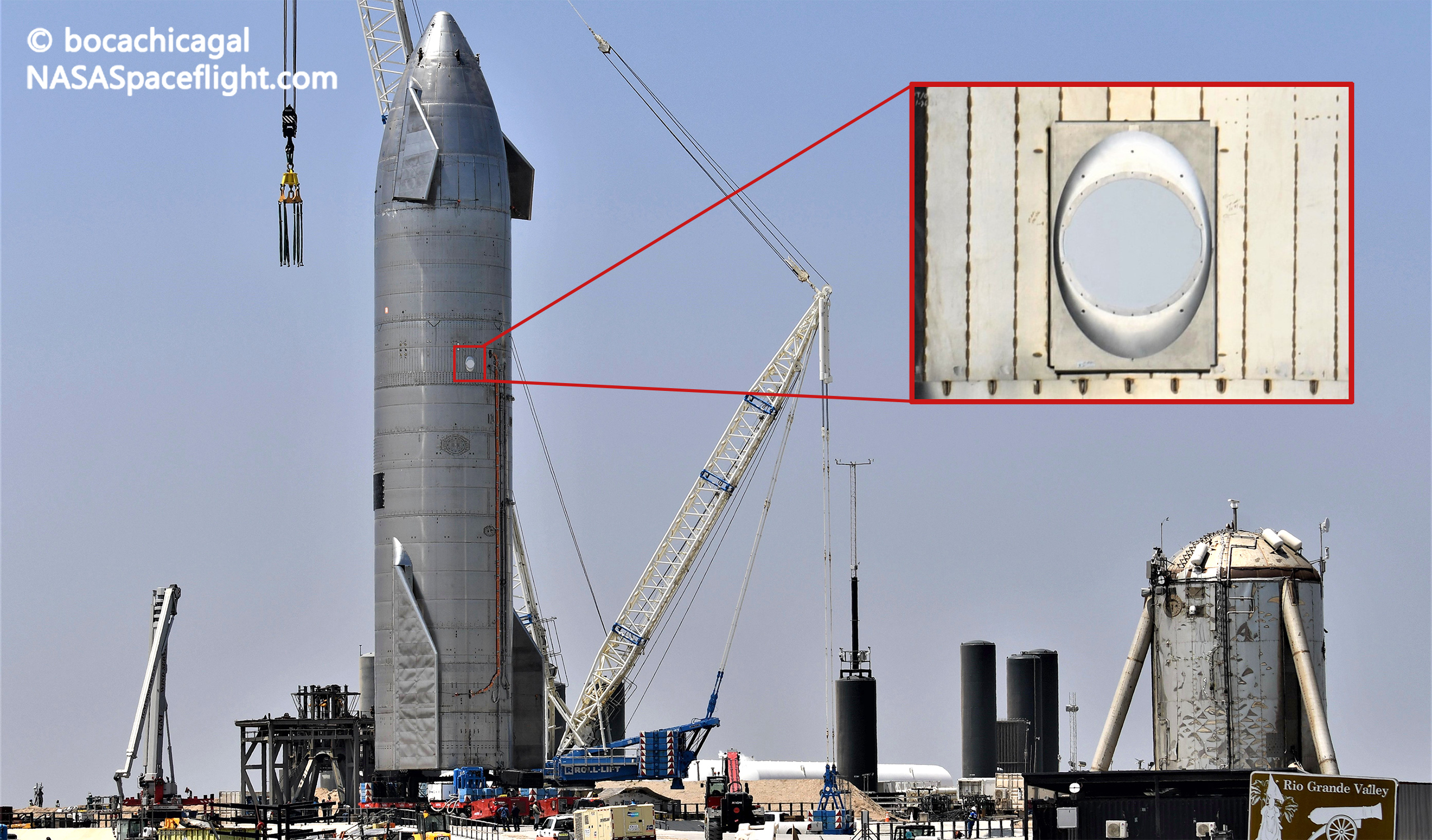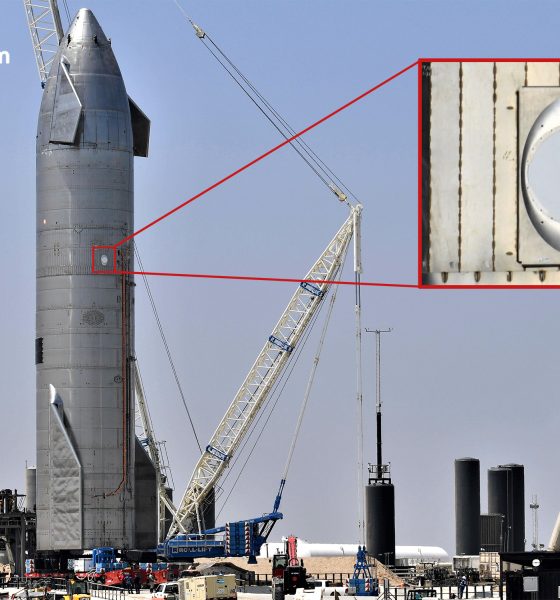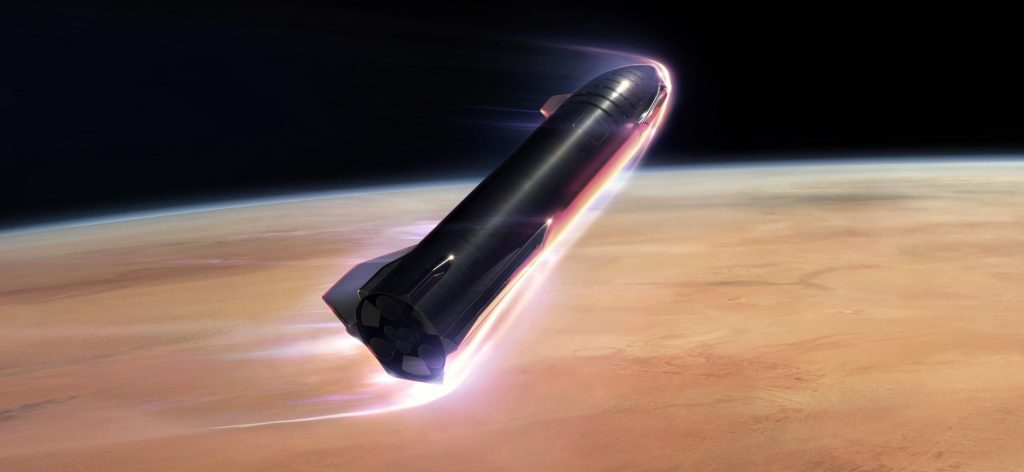

News
SpaceX says Starship can beat ‘plasma blackout’ with Starlink antennas
SpaceX has asked the FCC to allow Starship and its Super Heavy booster to communicate with Starlink during the rocket’s first orbital launch attempt, potentially unlocking game-changing capabilities.
Filed on June 28th, SpaceX’s Special Temporary Authority (STA) application contains a number of surprising details about the company’s plans to expand the experimental use of its Starlink satellite constellation to communicate with rockets in flight. That effort was first made public in April 2021 when a separate FCC application revealed plans to test Starlink on a Starship prototype. Starship serial number 15 (now known as Ship 15 or S15).
That particular prototype became the first of its kind to successfully launch and land in one piece on May 5th. Nothing is known about whether Starlink was actually used or how the Starship’s lone dish performed during the 10 kilometer (6.2 mi) flight test, but SpaceX’s plans to again combine both two Star– programs do offer some new lines to read between.
Relative to its first Starlink-Starship STA application, SpaceX splits no hairs in the ‘narrative’ attached to its latest request. Specifically, SpaceX repeatedly discusses the potential for Starlink to drastically improve the state of the art of routine spacecraft and launch vehicle telemetry and communications.
“SpaceX intends demonstrate high data rate communications with Starship and the Super Heavy Booster on the ground at the launch site in Starbase, TX during launch, during booster recovery, in flight, and during reentry. Starlink can provide unprecedented volumes of telemetry and enable communications during atmospheric reentry when ionized plasma around the spacecraft inhibits conventional telemetry frequencies. These tests will demonstrate Starlink’s ability to improve the efficiency and safety of future orbital spaceflight missions.“
SpaceX — June 28th, 2021
In short, in the two months since SpaceX first requested permission “to operate a single user terminal…during flight tests,” the company appears to have become extremely bullish about Starlink’s potential as a solution for rocket communications. The logical conclusion is that Starlink performed well during its trials aboard Starship S15 on the ground and in flight – possibly even exceeding SpaceX’s own expectations. Simultaneously, SpaceX is in the midst of expanding efforts to certify Starlink for aviation communications and has been generally ramping up tests on aircraft, ships, and road vehicles.
Indeed, at least in theory, the same attributes that allow Starlink to blow traditional consumer satellite communications solutions out of the water could make Starlink a boon for launch vehicle communications. That’s especially true for the test flights of experimental launch vehicles like Starship, where failure is an inevitable part of the development process. However, those launch failures are only beneficial insofar as they expand the knowledge base and allow lessons to be learned.

Data, in other words, is essential, and the more data recovered from test flights, the better. Even on modern rockets, state-of-the-art telemetry usually involves maximum bandwidth on the order of a few hundred to a few thousand kilobits per second, often requiring software and compression gymnastics and uncomfortable triage to ensure that all necessary telemetry keeps flowing.
If Starlink could expand that bandwidth from a few megabits per second (Mbps) to dozens or even hundreds of Mbps, SpaceX could extract unprecedentedly widespread and high-resolution telemetry from Starship and Super Heavy during their first orbital test flight, leaving a wealth of data for likely post-flight failure analyses.

Perhaps most surprising is SpaceX’s claim that Starlink antennas could allow Starship to maintain a strong communications link throughout orbital reentry. Traditionally, all spacecraft capable of reentry produce a superheated sheath of plasma as they careen into Earth’s upper atmosphere. That plasma effectively blocks most radio waves, creating an inevitable several-minute communications ‘blackout’ for any reentering spacecraft.
If Starlink can somehow allow SpaceX to break through that ‘plasma barrier,’ it would give the company an unprecedented capability invaluable for the process of perfecting orbital Starship reentry, descent, and landing – a process Musk expects to involve several unsuccessful attempts. According to SpaceX’s FCC application, Starship’s first orbital launch and reentry attempt could occur as early as August 2021.

Elon Musk
Elon Musk and Tesla AI Director share insights after empty driver seat Robotaxi rides
The executives’ unoccupied tests hint at the rapid progress of Tesla’s unsupervised Robotaxi efforts.

Tesla CEO Elon Musk and AI Director Ashok Elluswamy celebrated Christmas Eve by sharing personal experiences with Robotaxi vehicles that had no safety monitor or occupant in the driver’s seat. Musk described the system’s “perfect driving” around Austin, while Elluswamy posted video from the back seat, calling it “an amazing experience.”
The executives’ unoccupied tests hint at the rapid progress of Tesla’s unsupervised Robotaxi efforts.
Elon and Ashok’s firsthand Robotaxi insights
Prior to Musk and the Tesla AI Director’s posts, sightings of unmanned Teslas navigating public roads were widely shared on social media. One such vehicle was spotted in Austin, Texas, which Elon Musk acknowleged by stating that “Testing is underway with no occupants in the car.”
Based on his Christmas Eve post, Musk seemed to have tested an unmanned Tesla himself. “A Tesla with no safety monitor in the car and me sitting in the passenger seat took me all around Austin on Sunday with perfect driving,” Musk wrote in his post.
Elluswamy responded with a 2-minute video showing himself in the rear of an unmanned Tesla. The video featured the vehicle’s empty front seats, as well as its smooth handling through real-world traffic. He captioned his video with the words, “It’s an amazing experience!”
Towards Unsupervised operations
During an xAI Hackathon earlier this month, Elon Musk mentioned that Tesla owed be removing Safety Monitors from its Robotaxis in Austin in just three weeks. “Unsupervised is pretty much solved at this point. So there will be Tesla Robotaxis operating in Austin with no one in them. Not even anyone in the passenger seat in about three weeks,” he said. Musk echoed similar estimates at the 2025 Annual Shareholder Meeting and the Q3 2025 earnings call.
Considering the insights that were posted Musk and Elluswamy, it does appear that Tesla is working hard towards operating its Robotaxis with no safety monitors. This is quite impressive considering that the service was launched just earlier this year.
Elon Musk
Starlink passes 9 million active customers just weeks after hitting 8 million
The milestone highlights the accelerating growth of Starlink, which has now been adding over 20,000 new users per day.

SpaceX’s Starlink satellite internet service has continued its rapid global expansion, surpassing 9 million active customers just weeks after crossing the 8 million mark.
The milestone highlights the accelerating growth of Starlink, which has now been adding over 20,000 new users per day.
9 million customers
In a post on X, SpaceX stated that Starlink now serves over 9 million active users across 155 countries, territories, and markets. The company reached 8 million customers in early November, meaning it added roughly 1 million subscribers in under seven weeks, or about 21,275 new users on average per day.
“Starlink is connecting more than 9M active customers with high-speed internet across 155 countries, territories, and many other markets,” Starlink wrote in a post on its official X account. SpaceX President Gwynne Shotwell also celebrated the milestone on X. “A huge thank you to all of our customers and congrats to the Starlink team for such an incredible product,” she wrote.
That growth rate reflects both rising demand for broadband in underserved regions and Starlink’s expanding satellite constellation, which now includes more than 9,000 low-Earth-orbit satellites designed to deliver high-speed, low-latency internet worldwide.
Starlink’s momentum
Starlink’s momentum has been building up. SpaceX reported 4.6 million Starlink customers in December 2024, followed by 7 million by August 2025, and 8 million customers in November. Independent data also suggests Starlink usage is rising sharply, with Cloudflare reporting that global web traffic from Starlink users more than doubled in 2025, as noted in an Insider report.
Starlink’s momentum is increasingly tied to SpaceX’s broader financial outlook. Elon Musk has said the satellite network is “by far” the company’s largest revenue driver, and reports suggest SpaceX may be positioning itself for an initial public offering as soon as next year, with valuations estimated as high as $1.5 trillion. Musk has also suggested in the past that Starlink could have its own IPO in the future.
News
NVIDIA Director of Robotics: Tesla FSD v14 is the first AI to pass the “Physical Turing Test”
After testing FSD v14, Fan stated that his experience with FSD felt magical at first, but it soon started to feel like a routine.

NVIDIA Director of Robotics Jim Fan has praised Tesla’s Full Self-Driving (Supervised) v14 as the first AI to pass what he described as a “Physical Turing Test.”
After testing FSD v14, Fan stated that his experience with FSD felt magical at first, but it soon started to feel like a routine. And just like smartphones today, removing it now would “actively hurt.”
Jim Fan’s hands-on FSD v14 impressions
Fan, a leading researcher in embodied AI who is currently solving Physical AI at NVIDIA and spearheading the company’s Project GR00T initiative, noted that he actually was late to the Tesla game. He was, however, one of the first to try out FSD v14.
“I was very late to own a Tesla but among the earliest to try out FSD v14. It’s perhaps the first time I experience an AI that passes the Physical Turing Test: after a long day at work, you press a button, lay back, and couldn’t tell if a neural net or a human drove you home,” Fan wrote in a post on X.
Fan added: “Despite knowing exactly how robot learning works, I still find it magical watching the steering wheel turn by itself. First it feels surreal, next it becomes routine. Then, like the smartphone, taking it away actively hurts. This is how humanity gets rewired and glued to god-like technologies.”
The Physical Turing Test
The original Turing Test was conceived by Alan Turing in 1950, and it was aimed at determining if a machine could exhibit behavior that is equivalent to or indistinguishable from a human. By focusing on text-based conversations, the original Turing Test set a high bar for natural language processing and machine learning.
This test has been passed by today’s large language models. However, the capability to converse in a humanlike manner is a completely different challenge from performing real-world problem-solving or physical interactions. Thus, Fan introduced the Physical Turing Test, which challenges AI systems to demonstrate intelligence through physical actions.
Based on Fan’s comments, Tesla has demonstrated these intelligent physical actions with FSD v14. Elon Musk agreed with the NVIDIA executive, stating in a post on X that with FSD v14, “you can sense the sentience maturing.” Musk also praised Tesla AI, calling it the best “real-world AI” today.








